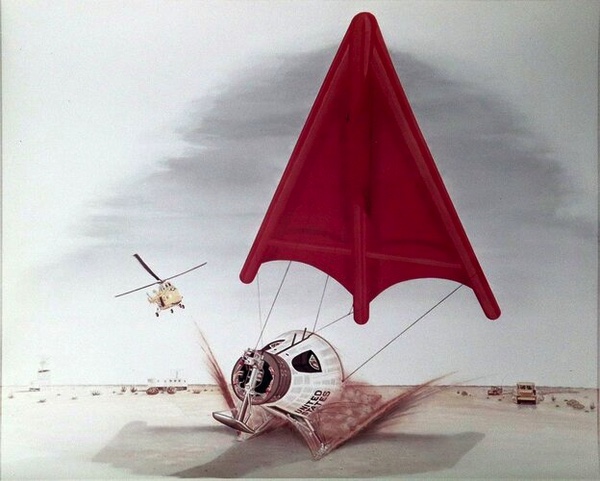Gemini’s wing and a prayer (part 1): Rogallo Wings, the Paresev, and crashes in the desertby Dwayne A. Day
|
| In the early 1960s the engineers thought that they had a solution, a radical new type of parachute-like device known as a Rogallo Wing. The only problem was that nobody knew if it worked. |
There was a good reason to develop the capability to land Gemini on land. Gemini’s predecessor, Mercury, splashed down at sea and this was expensive, requiring a fleet of ships and aircraft. Gemini’s program managers reasoned that if their spacecraft could come down on land, the recovery crew could be reduced to a few helicopters and a tracking plane, and maybe a truck to pick up the capsule. But there were two problems with this. First was the fact that landing on a hard surface increased the G-loads to the crew and could be potentially dangerous. The second was that land could be populated, and nobody wanted a Gemini spacecraft to smash through the roof of a Nevada family’s house. Any system for landing the spacecraft on land had to be both gentle and precise.[2]
In the early 1960s the engineers thought that they had a solution, a radical new type of parachute-like device known as a Rogallo Wing. The only problem was that nobody knew if it worked. That’s why NASA began an extensive test program. It did not always go well.
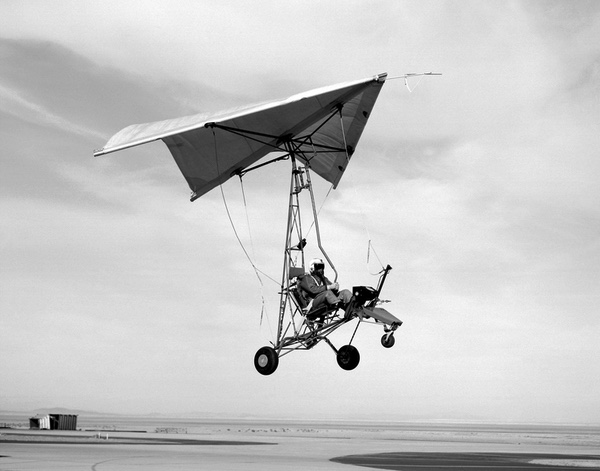 The Paresev I test vehicle. Note the control stick that is connected above the pilot. Milt Thompson disliked this configuration, which also required a lot of effort to move. After the Paresev I was destroyed in a crash, he ordered that the Paresev I-A have a more conventional control stick mounted below. (credit: NASA) |
Mr. Rogallo’s wing
Starting in the mid-1940s, Francis Rogallo, an engineer at the National Advisory Committee on Aeronautics’ (NACA) Langley Memorial Aeronautical Laboratory in Virginia, began working on a new kind of aerodynamic structure. Rogallo’s invention consisted of a lifting surface stretched over an inflatable frame. The entire structure could be folded into a small package and deployed in the air. It would have some of the attributes of a wing as well as a parachute, and Rogallo called it a paraglider. He believed that his new paraglider could help a spaceship glide back to the Earth. In late 1958, Rogallo’s employer NACA became part of the National Aeronautics and Space Administration. The Langley laboratory became a major field center for the new agency. Langley’s administration had already created the Space Task Group to design manned spacecraft, and by the second half of 1958 the STG, as it was known, had started work on the Mercury spacecraft.
Mercury was small, largely constrained by the booster rocket that would carry it into orbit. By January 1959 someone had proposed expanding the capsule to include a second astronaut, but this proposal was rejected as impractical at that time. In May 1959, STG’s director, Robert Gilruth, proposed studying the use of Rogallo’s paraglider for the follow-on to Mercury, then designated the Mercury Mark II.[3] But neither the Mercury Mark II nor the paraglider received funding. Although Rogallo had confidence in his wing, many other members of the STG were skeptical that the wing would deploy properly.
NASA continued studying the Rogallo wing for other purposes, including possibly assisting the recovery of Saturn I rocket stages. During 1959, Rogallo conducted wind tunnel tests of scale models of his paraglider. But one of the problems he encountered was accurately predicting the lift of what was essentially a flexible wing. NASA’s Ames Research Center also conducted test flights of an aircraft to simulate the landing profile of a paraglider, which required a steep descent toward an aim point and then a hard flare maneuver to touch down.[4]
In May 1961, as more money started to pour into NASA in the wake of Yuri Gagarin’s flight, Rogallo’s idea finally got some much-needed funding. Three companies were awarded $100,000 contracts by NASA to study “the design parameters of a system to provide spacecraft maneuverability and controlled energy descent and landing by aerodynamic lift.” The initial proposal was to “culminate in land recovery of a manned Mercury capsule during March of 1962.” The three companies were North American Aviation, Ryan Aeronautical Company, and Goodyear Aircraft Corporation. This became known as the Paraglider Development Program and incorporated several phases leading up to the production of a flight model and a training vehicle. These initial studies were for mounting a paraglider recovery system to a Mercury spacecraft, although it was clear that the Mercury program was coming to an end.[5]
| But something else happened in November 1961 that was to have a profound effect on the paraglider program: North American Aviation also won the contract to build the Apollo spacecraft. |
Phase I was completed in August 1961 and by November the Manned Spacecraft Center—the new name for the STG—awarded North American Aviation a contract to proceed with systems research and development to identify the configuration that would produce the best performance. The plan was to conduct wind tunnel testing at Langley and a flight test program in the Mojave Desert at NASA’s Flight Research Center. The company would also conduct a study of supersonic high-altitude deployment to increase range.[6]
But something else happened in November 1961 that was to have a profound effect on the paraglider program: North American Aviation also won the contract to build the Apollo spacecraft. This was a major win for the company, which had been locked out of the Mercury spacecraft development. Because Apollo was such a major contract, North American soon began transferring its best engineers from other projects to work on the Apollo contract. This included many of the people who were assigned to the paraglider. As one NASA engineer later put it, after this, North American’s quality control on the paraglider contract became “abysmal.”[7]
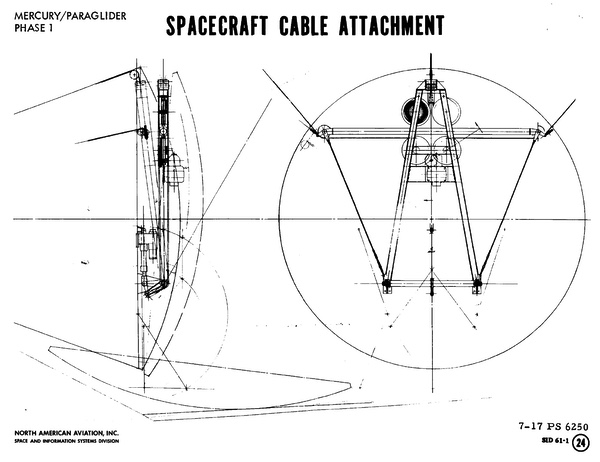 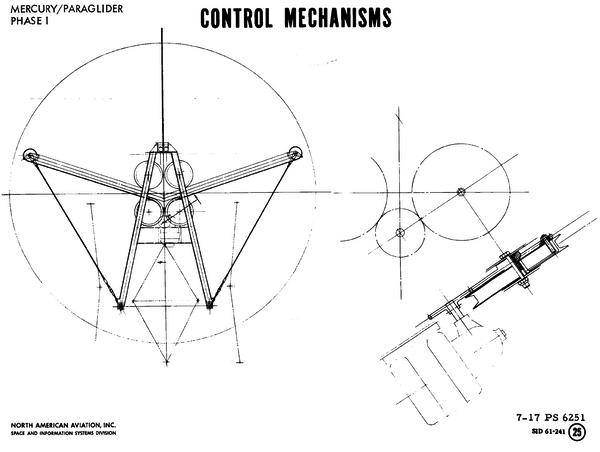 The cables for the paraglider were wound around drums located between the aft bulkhead of the spacecraft and the heat shield. Note that in this early concept, the heatshield would fold down to serve as part of the landing gear. Also note the gas canister for powering the controls. (credit: NASA) |
The Paresev
By late 1961 NASA had gained some experience with the Mercury spacecraft and NASA officials were hoping to produce a more capable craft, the Mercury Mark II that at the very least would have increased endurance. In late November, the Manned Spacecraft Center’s leadership decided to direct the paraglider research toward producing a landing system for the Mercury Mark II. On December 7, the Manned Spacecraft Center, or MSC, received formal approval to begin the Mark II.[8]
The early concepts for the Mercury Mark II were simply for a longer flying single-man spacecraft incorporating more consumables in an extended section behind the heatshield. But soon the Mark II evolved into a two-man spacecraft with even more capability: not only longer duration, but also the ability to maneuver in orbit to practice rendezvous and docking techniques required for the Apollo program.
Mercury was designed to land on its tail—its heatshield—and bob in the water. In contrast, the Mark II would be equipped with landing gear and would land on the ground on its side, carried to a precise location by its paraglider. The paraglider would be stored in the nose. A drogue parachute would pull the recovery compartment away from the spacecraft at 18,000 meters and pull the paraglider out of its canister at 15,000 meters. The wing would deploy and inflate, becoming operational around 14,000 meters.
With the paraglider deployed above their spacecraft, the astronauts could then steer their craft by controlling gas-operated cable reels. The reels were located behind the astronauts’ backs, between their spacecraft and the heatshield. According to the proposed work statement for the project, “The recommended method of pitch control is a drum located between the aft bulkhead and ablative heat shield, which shortens and lengthens a diagonal keel line and aft keel line by actuation of the drum controller to produce changes in angle of attack of the wing. Lateral control is achieved in a similar manner by differential reel-in and reel-out of the boom shroud lines.”[9]
Early illustrations of the potential vehicle showed the heatshield rotated down 90 degrees to serve as a landing skid, looking much like a child’s snow saucer, but this idea was soon abandoned. The astronauts would deploy the landing gear at an altitude of around 80 meters. The gear consisted of a nose skid and two outrigger skids. Just before touchdown the astronauts would pull up the nose of the spacecraft to increase wing lift and slow their rate of descent. They would touch down at around 75 kilometers an hour and then jettison the paraglider.[10]
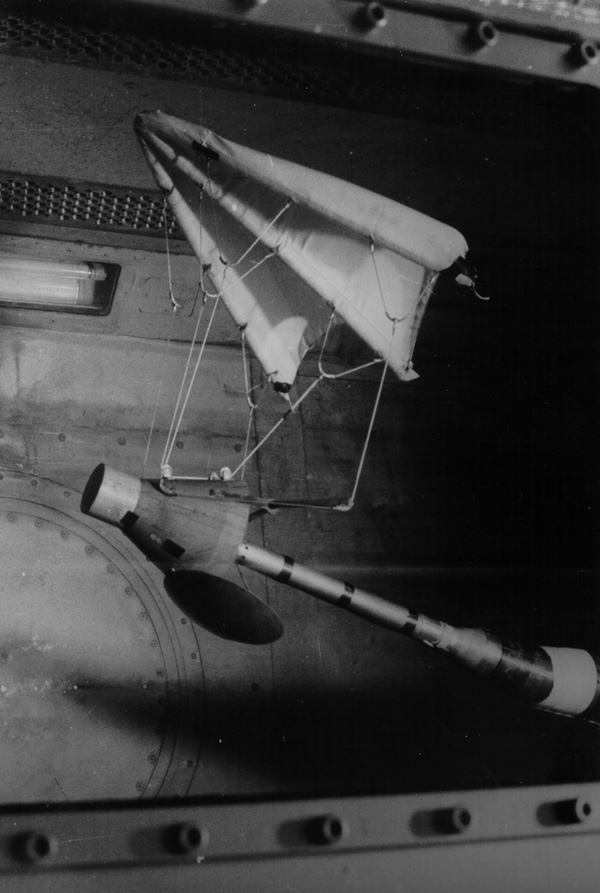  Two different wind tunnel tests conducted by contractors in 1961. Note the differences in the wings. Modeling the wing lift was difficult because of its flexibility. (credit: NASA) |
By early 1962, NASA publicly announced its plans to build the new spacecraft, now renamed Gemini. McDonnell, which already built Mercury, would build this updated version as well. NASA also announced that the spacecraft would use the new recovery technique. The first unmanned Gemini flight was scheduled for August 1963 using a standard parachute, followed a month later by the second mission using a paraglider. On February 28, managers and engineers held a meeting to determine where they could put the parachute and the landing gear inside the Gemini. The vehicle’s outer “mold line” had already been established, so all the equipment had to fit internally with no protrusions. However, the program managers directed that designers also develop a parachute capability for Gemini in case the paraglider was not ready in time. This proved to be a prudent decision.[11]
| Thompson believed that some method of returning spacecraft to land and bringing them down with some precision was a good idea. Thompson lent his support to those who were advocating the use of the Rogallo wing for Gemini. |
Although Gemini program managers generally seem to have had much confidence that the paraglider could be made to work, members of NASA’s Flight Research Center out in the Mojave desert—the people who had the most experience with testing experimental aircraft—had serious doubts about the paraglider. Even though the MSC engineers had plans to keep the parachute as a backup for the paraglider, Flight Research Center personnel thought that any plans to incorporate an unproven recovery method into a manned space vehicle were unwise.
Flight Research Center test pilot Milton Thompson thought that a vehicle capable of generating lift during re-entry, such as the Dyna-Soar manned spaceplane, was the best solution to returning to Earth from space. But the early American space program sought to reach space in the fastest possible way and that resulted in selecting ballistic reentry. By the early 1960s, the Dyna-Soar was still years from becoming operational, and Thompson believed that some method of returning spacecraft to land and bringing them down with some precision was a good idea. Thompson lent his support to those who were advocating the use of the Rogallo wing for Gemini.
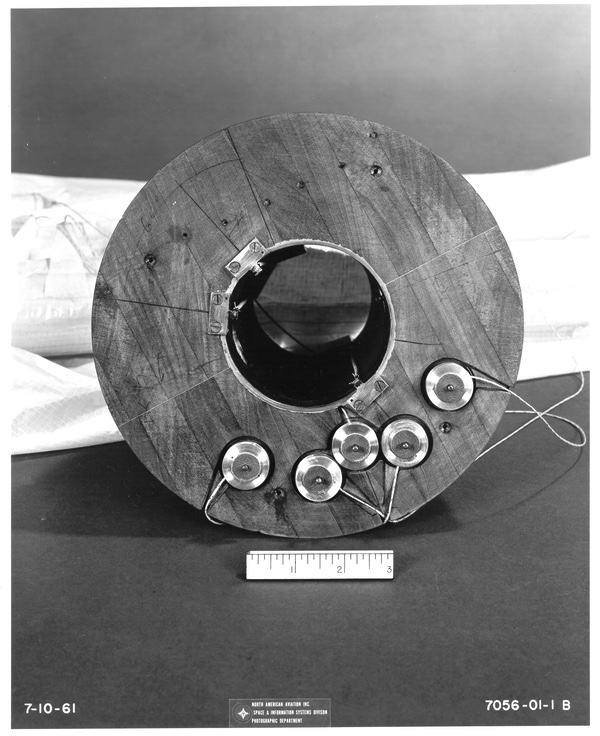 The connection points and steering control for the Rogallo Wing were mounted to the rear of the spacecraft. This wooden wind tunnel model was very basic and large scale tests were required to refine the design. (credit: NASA) |
In November 1961, Thompson met with the people who were working on the paraglider.[12] Thompson and fellow test pilot Neil Armstrong petitioned the flight center’s director Paul Bikle to build a simple paraglider. When Bikle denied their request, they started to build it on their own. Bikle quickly relented and approved construction of a single-seat research vehicle known as Paresev I.
Thompson was told by Francis Rogallo that Thomas Purcell, Jr., of Raleigh, North Carolina, had already built and flown a paraglider. So, Thompson and another pilot flew to the US East Coast to see it. Thompson was disappointed with the craft, which he thought looked like a “big kite with a seat suspended below it.” The wing was made of a clear plastic material stretched over three aluminum tubes with a cross brace between the center tube and the two outboard tubes.
The landing gear consisted of wagon wheels. But what really bothered Thompson was the pilot’s seat, which was a folding lawn chair. “That really destroyed our macho test-pilot image,” Thompson later wrote. Despite his first impression, the vehicle flew quite well. Thompson piloted it towed behind Purcell’s car.[13]
Thompson also went to San Diego to the Ryan Aircraft Company, which had built a small powered craft using a flexible Rogallo wing. Ryan had named it the “Fleep” for “flying Jeep” and was trying to sell it to the US Army. The Fleep had a small airplane engine, but the Flight Research Center needed to explore the flight envelope of an unpowered aircraft and that was what the Paresev I was for.
For a center that regularly tested supersonic aircraft, Paresev I was an odd, ugly, and flimsy-looking craft. Constructed from tubes, it was an open craft consisting of a seat on a triangular frame. A three-meter vertical mast behind the seat mounted the Rogallo wing, which consisted of fabric stretched over a V-shaped metal frame. The pilot could control the wing by operating a control stick that would tilt the wing forward or back, left or right.
The Paresev had an overhead control stick. The pilot could turn the vehicle by tilting the wing to the left or right and control the rate of descent by moving the wing up or down. Thompson began the initial flight tests of the Paresev I on January 25, 1962. They started with ground vehicle tows. At a speed of around 65 kilometers an hour it would lift off the ground.
Thompson found that the Paresev was difficult to fly. It required a lot of muscle power to control the stick, and the pilot had little time to flare the vehicle before landing. The lift-to-drag ratio was lower than expected, which the designers determined was because the wing was covered with a material commonly used on fabric-covered aircraft that produced more drag than they expected. Later wings would use Dacron.[14]
After several flights Thompson briefed a new pilot, Bruce Peterson, on how to fly the Paresev. Thompson believed that this was a mistake, because Peterson had no previous experience with unconventional aircraft. Peterson confirmed Thompson’s gut instincts on his very first test flight. Peterson lifted the Paresev off the lakebed to a height of about five meters and made a slow bank to the left and then a slow bank to the right, at which point the vehicle suddenly nosedived into the ground at a speed of about 56 kilometers per hour.[15]
At first Peterson appeared to be badly hurt, with a wound to his stomach, but medics soon determined that he primarily had cuts and bruises, including a gash to his hand where the control stick had shattered and struck him. The Paresev I, however, was demolished. Pieces of it were spread over the desert floor and the research team would have to start over with a new vehicle.
 Astronaut Gus Grissom and test pilot Milt Thompson and the Paresev I-A. The Paresev I-A was built after the crash of the Paresev I. This vehicle was towed into the air and released. Note the spelling of "Paresev" on the vehicle. (credit: NASA) |
The Paresev I-A eliminated several of the features that Thompson disliked about the first vehicle. He hated the overhead control stick, and so the new vehicle had a more conventional bottom-mounted stick. Thompson also was concerned about the attachment structure where the lower support structure was joined to the wing. The designers moved the wing pivot to decrease the control forces needed to control the vehicle. The Paresev I-A used cables to move the wing and the cables also served as a backup to the attachment structure to the wing: if the main attachment failed, the pilot would not suddenly find himself falling in a vehicle without a wing. They switched to Dacron for the wing fabric.[16] Thompson also trained astronaut Gus Grissom to fly the small vehicle based on the assumption that Grissom would eventually fly a similar wing on a Gemini mission.
| Thompson grew highly skeptical of the Paresev and parawing. Writing many years later he said that he knew of several cases where experienced pilots had serious accidents with the technology. |
The changes made the Paresev I-A easier to fly than its predecessor. Thompson flew it on May 18. By June he began flying a smaller wing on the vehicle, which was designated the Paresev I-B. The smaller wing had what was called a higher wing loading. This is a measurement of how much weight is supported by each square unit of area on the wing. A wing with a high wing loading would be smaller and lighter and thus could be packed into a smaller volume. But it would be less maneuverable.[17]
By late June the project suffered another failure. The program borrowed an Army L-19 observing plane to use to tow the Paresev. NASA would use the aircraft during the week and return it during the weekend when Army Reserve pilots would fly it. On June 28, Neil Armstrong was the tow plane pilot, his first time towing another aircraft. He towed Thompson into the air and then a communications error made the situation serious.
Armstrong started banking his tow plane as he approached the edge of the dry lakebed. Thompson became concerned that the Paresev was slowing down and told Armstrong to speed up. But Armstrong interpreted this to mean speed up the turn, not the airplane, and quickly Thompson found himself flying north in the Paresev with Armstrong flying south in the L-19, and with over 300 meters of nylon towline hanging slack between them.
With the lakebed quickly running out, Thompson realized that he had to drop the towline and land straight ahead. But there was no lakebed left and at around the same speed that a car travels on a highway he came down into the sagebrush and mesquite of the Mojave Desert. He bounced once and then slammed nose first into the ground. Miraculously, Thompson was uninjured. He immediately unhooked himself and began running away from the aircraft, concerned that it might explode. Only a few seconds later did he realize that this was an instinctual reaction, and silly—the Paresev had no engine and no fuel.[18]
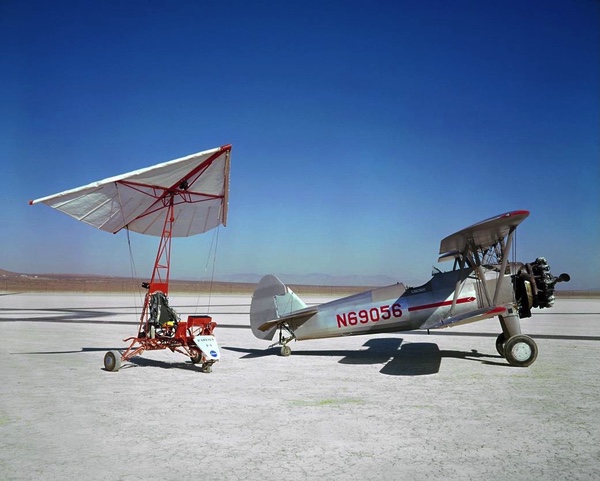 The Paresev IA test vehicle and the Stearman biplane used to tow it into the air. (credit: NASA) |
Thompson had other experiences that were simultaneously comical and dangerous. Because the vehicle had no instrumentation system, its performance had to be measured by ground observation. But the small craft was difficult to spot on the ground tracking cameras, so somebody suggested putting a smoke bomb on the Paresev to make it easier to see at a distance. They did this and Thompson triggered it in flight, only to discover that rather than trailing behind the aircraft, the smoke circulated underneath the wing, enveloping him in an acrid, blinding orange cloud. Fortunately, the smoke burned out before he reached the ground and he landed successfully.[19]
The Gemini paraglider could not use the same kind of wing tested on the Paresev because Gemini’s wing had to be stowed inside the spacecraft and deployed. The paraglider wing would use inflatable booms. North American built a half-size wing for testing on the Paresev, which the research team designated the Paresev I-C. During its first test flight Bruce Peterson crashed it due to high control forces. They redesigned the controls to give the pilot more control authority and Peterson made a successful flight on March 26, 1963.[20]
The subscale parawing was able to establish a stable glide. The real problems were experienced in deployment. As Thompson later wrote, the parawing was deceptive: just because it looked simple, people mistakenly believed that it was simple to fly.[21] Seven pilots flew the Paresev for a total of 341 flights in slightly more than two years, and the aircraft crew chief painted the names of each pilot who broke a nose wheel onto the structure of the Paresev. They broke the nose wheel six times.[22]
Thompson grew highly skeptical of the Paresev and parawing. Writing many years later he said that he knew of several cases where experienced pilots had serious accidents with the technology. Rather paradoxically, he concluded that inexperienced pilots might do a better job flying them, because they would not expect as much out of the vehicle as pilots who had flown other aircraft. Even after NASA had abandoned the approach to landing, other organizations sought to develop the technology and also met with only limited success.[23]
 The Paresev I-C was equipped with a wing with inflatable struts. Note the different wing compared to the Paresev I-A. All of the Paresev vehicles crashed, but some crashes were more gentle than others. (credit: NASA) |
Next: Wind tunnels, models, helicopters, and more crashes in the desert.
- The author wishes to acknowledge the generous assistance of Ed Hengeveld and former Johnson Space Center historian Glen Swanson, who both supplied many of the photographs used in this article as well as the primary source material. He also wishes to thank Stewart Bailey of the Kalamazoo, Michigan Air Zoo Museum. The initial inspiration for this article came during a visit to the Air Zoo, which houses the El Kabong I test vehicle. Mr. Hengeveld’s Fall 1993 article in Quest magazine also provided significant guidance and information used in this article.
- E. Hengeveld, Land Landings for Gemini, Quest, Fall 1993, pp.4-12.
- B.C. Hacker and J.M. Grimwood, On the Shoulders of Titans, NASA, 1977, p.19.
- F.J. Drinkwater III and R.S. Bray, NASA Ames Research Center, A Landing Technique Applicable to Satellite Re-Entry Vehicles, Paper presented at Annual Symposium of the Society of Experimental Test Pilots, Beverly Hills, California, October 8-10, 1959.
- Ibid., p. 44; J.M. Grimwood, B.C. Hacker, and P.Z. Vorzimmer, Project Gemini: A Chronology, NASA, 1969, pp. 8-9; 16; Proposed Work Statement for Phase I, Paraglider Recovery of Mercury Manned Satellites, North American Aviation, Inc., May 5, 1961; H.H. Cutler, Assistant Manager, Contracts and Proposals, Space & Information Systems Division, to R.R. Gilruth, Director, Langley Research Center, NASA, “Transmittal of a Cost Proposal for Paraglider Recovery of Mercury Manned Satellites,” May 20, 1961; Mercury/Paraglider Phase I, North American Aviation, Inc., June 1961; Mercury/ Paraglider Phase I, Mid-Term Progress Report, May 27, 1961- July 13, 1961, North American Aviation, Inc., July 1961; Ryan Aerospace, Program Review, Flex Wing Landing System for Mercury Type Space Craft, June 2, 1961; Ryan Aerospace, Design Study, Flex Wing Landing System for Mercury Type Space Craft, June 2, 1961; Ryan Aerospace, Study of a Paraglider Landing System for Manned Spacecraft, August 26, 1961; Ryan Aerospace, Mercury Landing System Wing Deployment Test Program and Description of Test Vehicle, June 27, 1961; Ryan Aerospace, A Chronological History of the Paraglider Development Test Program, September 11, 1961; Goodyear Aircraft Corporation, Paraglider Development Program Phase I Study Final Report, August 1961; Goodyear Aircraft Corporation, Paraglider Development Program Phase I Study Supporting Tests, August 1961.
- On the Shoulders of Titans, p.99.
- Ibid., p.75.
- Proposed Work Statement for Phase II Paraglider Development Program, North American Aviation, Inc., August 23, 1961.
- On the Shoulders of Titans, p.92; Project Gemini: A Chronology, pp.47-48.
- Ibid., p.27; 43.
- M.O. Thompson and Curtis Peebles, Flying Without Wings, Smithsonian Institution Press, 1999, p.32.
- Ibid., p.33.
- Ibid., p.35.
- Ibid., p.40.
- Ibid., p.41.
- Ibid., p.42.
- Ibid., pp.43-44.
- Ibid., pp.44-45.
- Ibid., p.52.
- Ibid., p.53.
- Ibid., p.48; 55.
- Ibid., p.55. See also: North American Aviation, Paraglider Development Program Phase I Final Report, August 15, 1961; North American Aviation, Addendum to Paraglider Development Program Phase I Final Report, September 22, 1961; North American Aviation, Mercury/Paraglider Phase I (n.d. but probably June 1961).
Note: we are now moderating comments. There will be a delay in posting comments and no guarantee that all submitted comments will be posted.
